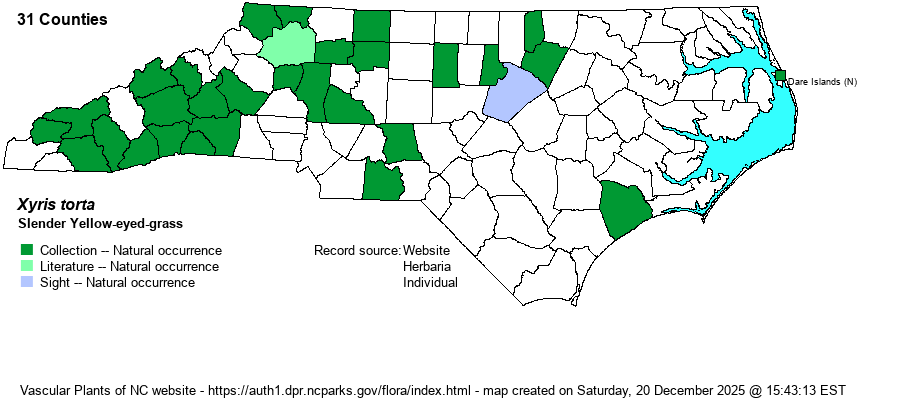| Author | J.M. Smith | |
| Distribution | Mountains and Piedmont; disjunct to Onslow County (no specific location) and to Dare County (Nags Head Woods). The only NC member of the genus essentially limited to the Piedmont and Mountains; all other Xyris are strictly or nearly limited to the Coastal Plain and Sandhills.
NH to WI, south to central GA, TX, and OK. | |
| Abundance | Fairly common but local in the Mountains and western Piedmont; very uncommon in the rest of the Piedmont, mainly in northern counties; extremely rare in the Coastal Plain. | |
| Habitat | Montane seepages, bogs, freshwater marshes, streambanks, ditches; rarely at pools and wet places on granitic flatrocks and domes. Discovered in extensive, clayey, seepy streamhead ecotones in the Uwharrie Mountains of Montgomery County in 2021. | |
| Phenology | Flowering and fruiting June-August. | |
| Identification | Slender Yellow-eyed-grass is a medium-sized species and has an expanded, bulbous base and twisted stem and leaves. Thus it resembles Carolina Yellow-eyed-grass (X. caroliniana) (and a number of specimens have been misidentified), but its head is short and ovate (not long and tapered to both ends as in that species) and leaf bases are pinkish-purplish to yellow-green (vs. lustrous chestnut color in X. caroliniana). See Godfrey & Wooten (1979, p. 491) for additional characters. | |
| Taxonomic Comments | None
Members of Xyris are easy to identify to genus, but can be a challenge to identify species. Careful observation of a few features with a hand-lens is usually sufficient. Close attention must be paid to the flowering head, which is composed of overlapping brown scales. Immediately behind each scale are two brown "lateral sepals"; the margins of these may be feathery or irregularly lacerate (cut into narrow segments) or finely cut into short, comb-like prickles. Lateral sepals may be hidden or a bit longer than each scale. The flowers themselves are usually of little diagnostic value, other than time of flowering -- morning vs. afternoon. Seed size and ornamentation can also be useful characters, but require a dissecting scope to see well. Note also whether leaves and scapes (stems) are twisted and the color of the basal portion. All species have 2-ranked leaves, but in some species the leaves are arranged in a broad, fan-like shape. Finally, note the leaf and stem surface texture -- whether smooth of with little pale bumps. See Godfrey & Wooten (1979) for detailed descriptions and drawings. | |
| Other Common Name(s) | Mountain Yellow-eyed-grass, Twisted Yellow-eyed-grass | |
| State Rank | S3 | |
| Global Rank | G5 | |
| State Status | | |
| US Status | | |
| USACE-agcp | OBL link |
| USACE-emp | OBL link |

